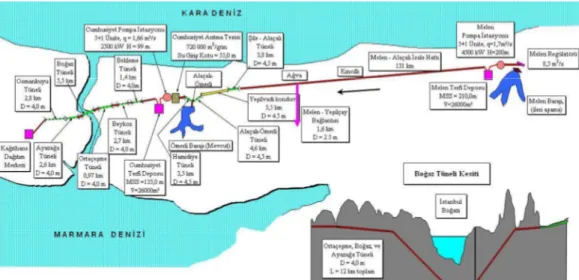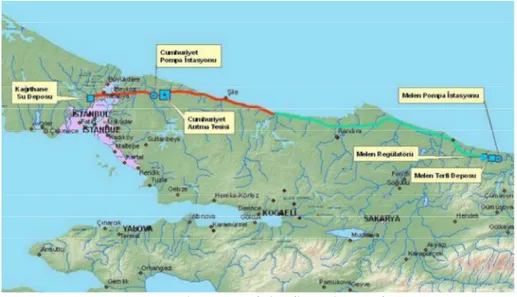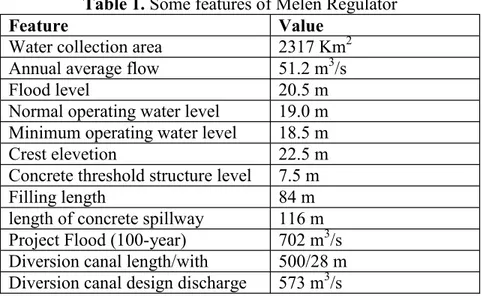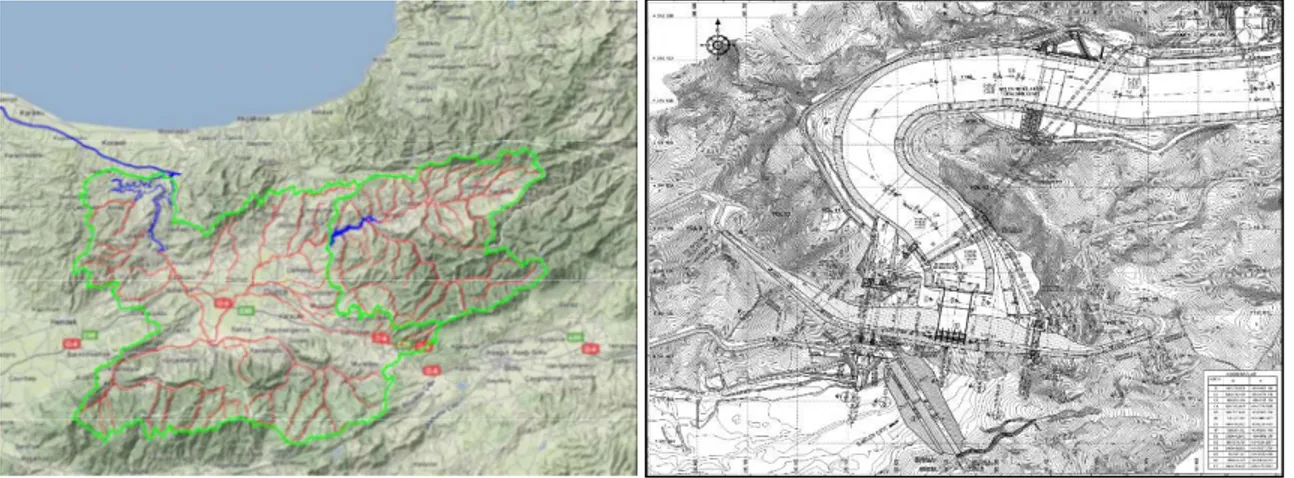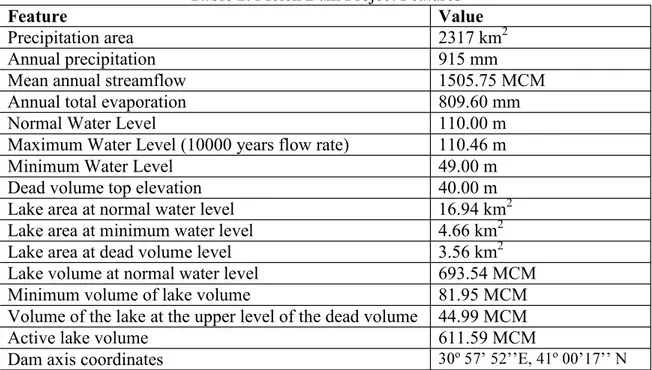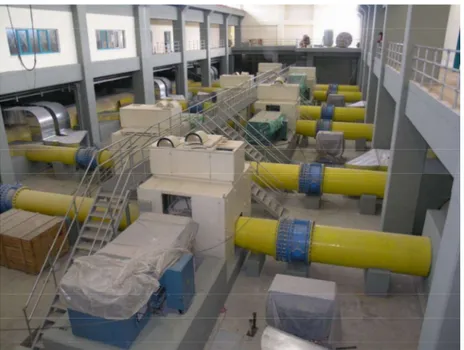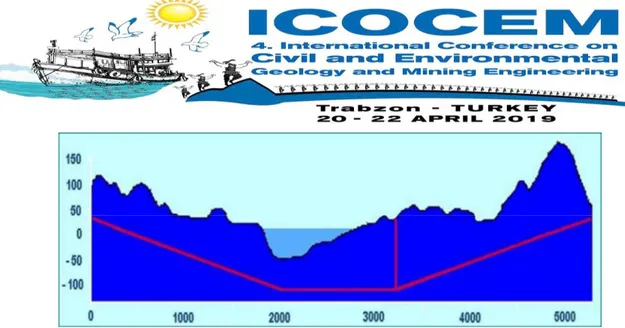Principals Of Planning And Realization Of Greater Melen Water Supply
Project, Turkey
1, Ali DANANDEH MEHR1*
1 Civil Engineering Department, Antalya Bilim University, Turkey
*Corresponding Author: ali.danandeh@antalya.edu.tr
Abstract
The Greater Melen water supply Project (GMP) is a large-scale interbasin freshwater transfer project that provides domestic and industrial water requirements of Istanbul. Its foster resource is Melen River, lying in D zce Province, Black Sea region. In addition to water supply, hydroelectric power generation has been aimed through a hydroelectric power plant in order to benefit from the energy of the water raised behind Greater Melen Dam. The GMP consists of different components including (but not limited to), interbasin water governance, quality characteristics of transferred water, construction technology, and potential hydroelectric power generation, particularly in heavy rainfall seasons. In this paper, the main characterises of GMP is briefly reviewed and the principals of planning and realization of the project have been highlighted. In addition, technical features of the hydraulic structures that were constructed during different stages of the project have been summarized. The economic and social characteristics of the project have been discussed as well.
Keywords: Greater Melen Project, Interbasin freshwater transfer, Istanbul water demand
Introduction
Istanbul has a population of nearly 15 million people with potential grows upto 21 million by 2050 (van Leeuwen and Sjerps, 2016). In parallel with the increase in population, daily water demand is grow due to changes in lifestyle, income level, migration, and eating habits. Today, daily gross water demand in the city is estimated to be 175 liter per capita, and this figure is expected to reach liter per capita by 2050 including industrial usage (Cuceloglu et al. 2017). A short history of water supply for the city was well documented by Saatci (2013). The city experienced a severe drought during the period 1989-1990 that revealed the lack of a sustainable water supply system for the province. During 1993-1994, Istanbul lived through another severe drought so that water could be supplied to residences only once a week and, each apartment made their own reserve tanks to cope with the water shortages (Saatci 2013). To solve such problem, a large-scale interbasin freshwater transfer project was evaluated on the basis of potential water from two catchments: Sakarya and Melen River basins. Between these alternatives, Melen River was the complementary water resource of Istanbul mainly owing to its cleaner water. With the decree issued in 1990, the idea of bringing water from Melen River to Istanbul was officially put forward for the first time. For a major project to be proposed by Turkey, 1.4 billion dollar credit allocation proposal from Japan has been approved and accepted for use for the project. In addition, the required feasibility report for
the use of the loan was prepared by the company of Nippon Koei in 1991. The main purpose of the project, which is known as Greater Melen Project (hereafter GMP), is to supply water to the Istanbul province which needs a large amount of water with opportunities of modern technology and water transfer between the watersheds. The GMP consists of variety of components (Figure 1). This article reviews principals of planning and realization of this project that has been carried out in several steps and took quite a long time.
Figure 1. The general scheme of the Great Melen Project
Overview of GMP phases
The GMP has a major point for the solution of drought in Istanbul. In order to get the required credit from Japan, the feasibility report of GMP was prepared by Nippon Koie Company in October 1991. The GMP contained four phases to be carried out in accordance with Istanbul water demand. At the beginning, the project was designed to provide a total of 1190 million cubic meters of water with the four phases as below:
268 million cubic meters in the first phase to
in the second phase 307 million cubic meters in the first phase in the third phase 307 million cubic meters in the first phase in the fourth phase 308 million cubic meters in the first phase
After completing the feasibility report, the number of phases were reduced to three, and the total amount of 1070 million cubic meters water were decided to provide for Istanbul for its consumption up to 2040 and later. The revised feasibility report was prepared by the Melen Consultant Group in January 1997, and the project phases were modified as stated below.
At the first phase (see Figure 2), the head of water in Melen Regulator is increased up to 299m using Melen pumping center and then using 153 pipeline and 24.2 km Tunnel line the water is transferred to Cumhuriyet water treatment plant which has capacity of 720.000 cubic meters per day. Then, the water is transferred to Istanbul Water and Sewerage Administration
(ISKI) and distribution network.
Figure 2. Main parts of the first phase of GMP
Construction system of GMP in the first phase includes 11 work packages as mentioned below:
1. Melen Regulator, Melen and Cumhuriyet Pumping Systems 2. Melen Pumping Depot
3. -Cumhuriyet Sewage treatment Plant Line 4.
5. Republic Drinking water Treatment Plant 6. Republican Promotion Depot
7. Construction of Bosporus Tunnel
8. Supply of 1st Party Steel Pipe and Special Parts 9. Supply of 2nd Party Steel Pipe and Special Parts 10. 3rd Party Steel Pipe and Special Parts Supply 11. 11 Energy Supply System
The scope of the services in all these work packages is as follows: 1. Soil surveys and geological studies
2. Review of the present Feasibility Report,
3. Preparation of implementation projects (except treatment plant process structures) 4. Preparation of contract documents (including steel pipe and special parts supply
works)
5. Land surveying (making maps) and preparing expropriation plans, 6. Preparation of EIA Report and Environmental Monitoring Program, 7. Preparation of construction tender documents,
9. Construction supervision services (except dam, throat water passage tunnel and conduit).
Melen Regulator is planned for raising water to be pumped before the dam is made. The main features of the regulator are given in Table 1.
Phases 2
The second phases of the GMP project are briefly explained below. The second transmission line, water tank, pumping center, switchyard and environmental regulation were accomplished in this phase. As a result, an additional 307 million cubic meters of water will be provided annually from the Melen Regulator in this phase. The main component of the project in this phase are as follows:
Drinking water transmission steel pipeline between Melen pumbing tank and Kocaali Region in Sakarya Province
Drinking water transmission steel pipeline between Melen pumping station and Melen Promotion Tank
water intake structure and settling pool
Water transmission channel, switchyard center landscaping works
drain lines in various diameters,
307 million cubic meters per year without dam. However, providing regular water supply to Istanbul cannot realize with only regulator. Therefore, this situation was reported to DSI with its letter dated 4.10.2011. The letter contains that the necessity of Melen Dam's significance for the water supply security of Istanbul.
Table 1. Some features of Melen Regulator
Feature Value
Water collection area 2317 Km2 Annual average flow 51.2 m3/s
Flood level 20.5 m
Normal operating water level 19.0 m Minimum operating water level 18.5 m
Crest elevetion 22.5 m
Concrete threshold structure level 7.5 m
Filling length 84 m
length of concrete spillway 116 m Project Flood (100-year) 702 m3/s Diversion canal length/with 500/28 m Diversion canal design discharge 573 m3/s
Phases 3
The third phase of the project includes the 3rd stage of the transmission line and the 3rd stage of the reservoir and pressure promotion system. The Melen Dam project is one of the main structures in this phase. The Melen Dam project aimed to utilize the water potential of the Great Melen River which is one of the major rivers of the Western Black Sea Basin. In addition, the water supply has purposed at meeting the drinking, industrial and industrial water needs of the Istanbul metropolitan area until 2071 in the first place. Also, hydroelectric power generation has been added to the project to benefit from the energy of the water raised in the planned Melen Dam, especially during the rainy years. From a various aspect, the Melen Dam provides to improve of the water and soil resources, besides, the economic and social developments of people who live in this region are contributed. Figure 2 shows stream network and general plan of the Melen Dam. The main surface water of the project includes Efteni Lake where Aksu creek flows.
Figure 3. Melen Dam basin (left) and its general plan (right)
In the Melen Dam project, nine main units of projects are Dam Body, Cut-Off Excavation, Derivation Tunnels, Cofferdams, access roads, Transmission Line Tunnels, Melen Regulator Gravel Gate Pump Station, Lake Area Concrete Covering, and Material Quarries. The 3rd transmission line in the third phase of GMP has a diameter of 2.5 meters, delivers 307 million cubic meters of water per year and provides additional pumps and additional treatment plants for this purpose.
The dam is an effective method for protection from flood.There is no current observation station in the project site which continuously measures the solid matter when the solid-state condition of dam is observed.
Directorate of Erosion and Pollution Control Department of the Directorate of Survey and calculation of the dead volume formula: 2317 * 400 * 50 cubic meters. For 50 years, an estimated 46.34 million cubic meters of sediment is deposited in the dam. The volume of the
reservoir of the Melen Dam was calculated in two ways. The first way, the volume of the reservoir was 1.020.000.000 cubic meters with the total flow curve (Alp, 1996). With the successive hills method, the chamber volume was calculated to be 943.4 million cubic meters. Other characteristics of the dam were given in Table 2.
Table 2. Melen Dam Project Features
Feature Value
Precipitation area 2317 km2
Annual precipitation 915 mm
Mean annual streamflow 1505.75 MCM
Annual total evaporation 809.60 mm
Normal Water Level 110.00 m
Maximum Water Level (10000 years flow rate) 110.46 m
Minimum Water Level 49.00 m
Dead volume top elevation 40.00 m
Lake area at normal water level 16.94 km2
Lake area at minimum water level 4.66 km2
Lake area at dead volume level 3.56 km2
Lake volume at normal water level 693.54 MCM
Minimum volume of lake volume 81.95 MCM
Volume of the lake at the upper level of the dead volume 44.99 MCM
Active lake volume 611.59 MCM
Dam axis coordinates
Phases 4
The last phase of the project includes fourth transmission pipeline. It is 2.5 meters in diameter and 308 million cubic meters of water is delivered per year and additional pump and treatment plant construction works. Thus, the fourth phase were not carried out, the gradations were reduced to 3 parts. The first stage of the pipeline is 2.5 meters in diameter and the pipelines of the second and third stages are 3 meters in diameter.
Arrangements of project
Some alterations were made at some points during the project progress. For instance, in 2006-2007, the amount of rainfall decreased to 413 millimeters (kilograms per square meter) when Hence, it was necessary to take urgent measures in order not to interrupt water in Istanbul. During this period, the General Directorate of ISKI started to follow the project more carefully in the IMC (1999) ISKI Master Plan.
Istanbul Bosporus water tunnel
This tunnel is designed to transport the treated water from the Asian continent to the European continent. The Bosphorus Strait the alternatives that the water tunnel can pass through are
shown in Figure 4. It is necessary to be careful in the design of the pipeline. Because in the European part, the pipe goes to the shore line at a depth of 45 meters with a steep and steep slope. For this reason, HDPE type pipe with more flexible structure is preferred for pipe material selection. In this tunnel with circular cross-section and covered concrete, the length of the concrete covered section is 4 meters in diameter and 4100 meters in length. Water passing capacity is 32 cubic meters per second. Details of the planning and principles of design of transmission line of GMP is presented by Gulbahar (2016).
Figure 4. Cross Section of the Bosporus Water Tunnel Distinctive features of GMP
Melen Project has features that attract the attention both in Turkey and the world. Some of these features are presented in this section. The GMP s the work of bringing water to Istanbul with 3 pipelines in 3 stages of construction of Grea
-stage plan of this huge project worldwide is shown in Figure 5. The first diameter of the pipelines placed on the same
excavation ditch is 2.5 meters and the other two are 3 meters. A section with pipeline
excavation trench and pipes is shown in Figure 6. Along the pipelines, the trench was opened about 50 meters wide and 5.2 meters deep. The pipes are buried at least 1 - 1.5 meters deep from the ground. The waters taken from the Great Melen River are pressed to Istanbul with a large number of pumps, each having a maximum height of 220 meters. A picture of the pump stations is shown in Figure 7. Specially manufactured steel pipes which are resistant to 340 meters (34 atmospheres) pressure have been selected to prevent the pipes from exploding. European side with the Bosphorus Water Tunnel, which is 135 meters deep inside the
Bosphorus Strait and having an internal diameter of 4 meters. The cross-sectional diagram of the Bosphorus Water Tunnel is given in Figure 8. The project is a water transfer project between basins. The water taken from the Great Melen Creek in the Melen Basin crosses the
ferred to Istanbul. GMP is an intercontinental water transfer project. The water of the Melen Creek in Asia continent reached the European side by passing a water tunnel in the Bosphorus. Melen System is Turkey's largest drinking water project. Melen Project, 70 million cubic meters of water annually 1 billion in Turkey with the transfer, perhaps the world, is the largest drinking water project. If this project is based on the use of 200 liters of gross water per person per day, the water requirement of a city with a population of approximately 10 million can be met.
Figure 5. Melen Project's 3-line pipelines plan
Figure 6. Exemplary section of the route where three pipelines are placed
Figure 8. Melen Project Istanbul Strait Water Tunnel cross-section diagram
The first water in Istanbul was launched in 2007 with the Melen Project. The history of water in Istanbul, which has suffered from water shortages throughout history, is a turning point in the transition from water scarcity to water abundance. In this respect, the Melen Project is considered to be a milestone for the Istanbul water situation. The project is the largest investment in drinking water in the Republican era in Turkey. This project, with an approximate cost of $ 3 billion, is the largest budget drinking water project investment of the Republican Period. All work carried out in Turkey, contractors, engineers, technicians and workers was carried out with. It is also worth to mention that most of the project was made with the national capital and labor force.
Results and Suggestions
Water has been one of the most basic needs of people since the past. According to the water needs of the human settlements settled on the edges of the water. Turkey is surrounded by seas around and is a country with water resources. Each day its population increases. Especially, Istanbul's population growth rapidly. Due to the increase in population and changes in precipitation rates, the need for water has increased in recent years. Therefore, the idea of the Melen project was developed, if we briefly explain this project: It was aimed to bring water from Melen Creek, which is about 180 km away from Istanbul and poured into Black Sea. As a result of GMP, the first and second stages of projects (excluding the dam) were completed to Sakarya with the Istranca
supplied to Istanbul from these projects. Additionally, the third gradation is about to end. The Manavgat River Project is inactive due to the initial planning error. The Great Melen 3rd phase and dam construction with Gerede project has reached the last stage. We are able to find solutions to the water problem by using the resources around us with our engineering intelligence. However, no resource is unlimited, and although it tries to protect the environment, it may have some side effects on the environment. Thereby, we should appreciate the value of our country, respect and protect our natural resources. Water is not just a resource needed by people, it is a common value of existence. Therefore, smart and effective utilization is required which aids the studies to have a long-lasting effect.
References
Cuceloglu, G., Abbaspour, K., & Ozturk, I. (2017). Assessing the water-resources potential of Istanbul by using a Soil and Water Assessment Tool (SWAT) hydrological model. Water, 9(10), 814.
Project. -28.
Saatci, A. M. (2013). Solving water problems of a metropolis. Journal of Water Resource and Protection, 5(04), 7.
van Leeuwen, K., & Sjerps, R. (2016). Istanbul: the challenges of integrated water resources Environment, development and sustainability, 18(1), 1-17.
